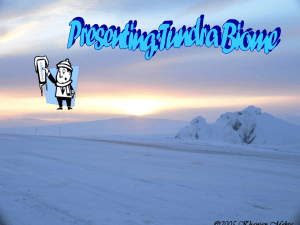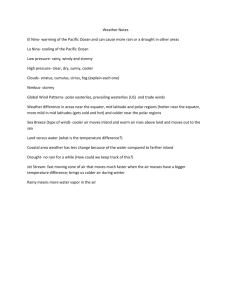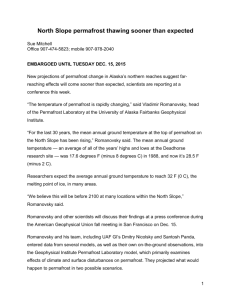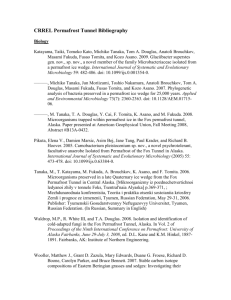Topic 8: Extreme Climates
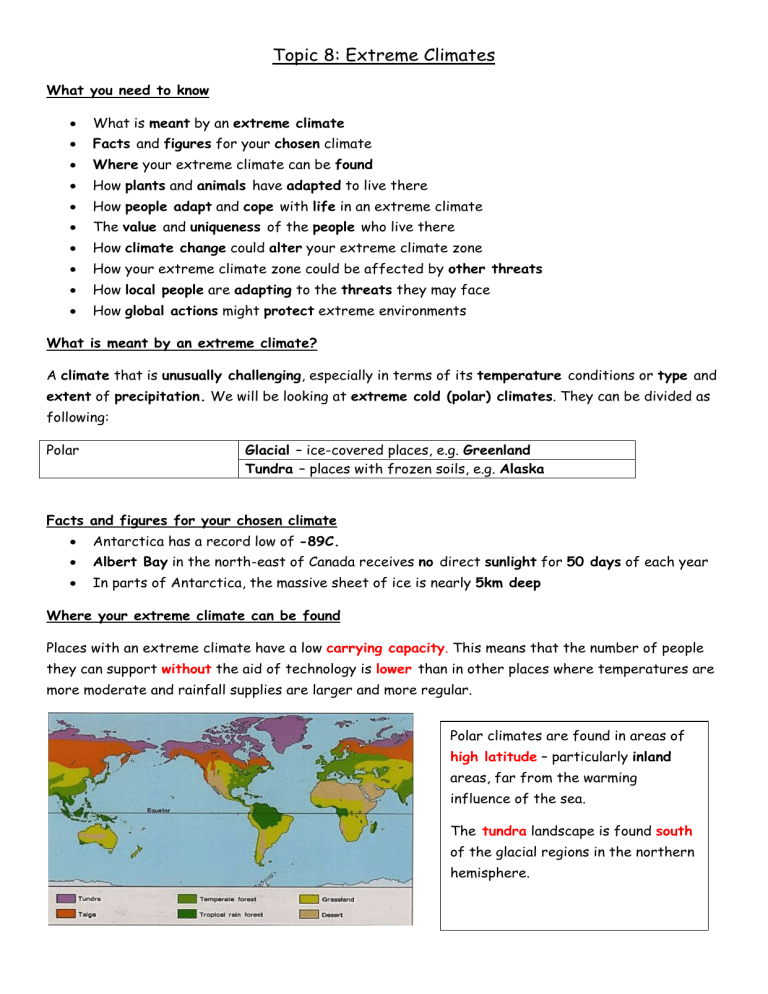
Topic 8: Extreme Climates
What you need to know
What is meant by an extreme climate
Facts and figures for your chosen climate
Where your extreme climate can be found
How plants and animals have adapted to live there
How people adapt and cope with life in an extreme climate
The value and uniqueness of the people who live there
How climate change could alter your extreme climate zone
How your extreme climate zone could be affected by other threats
How local people are adapting to the threats they may face
How global actions might protect extreme environments
What is meant by an extreme climate?
A climate that is unusually challenging, especially in terms of its temperature conditions or type and
extent of precipitation. We will be looking at extreme cold (polar) climates. They can be divided as following:
Polar Glacial – ice-covered places, e.g. Greenland
Tundra – places with frozen soils, e.g. Alaska
Facts and figures for your chosen climate
Antarctica has a record low of -89C.
Albert Bay in the north-east of Canada receives no direct sunlight for 50 days of each year
In parts of Antarctica, the massive sheet of ice is nearly 5km deep
Where your extreme climate can be found
Places with an extreme climate have a low carrying capacity.
This means that the number of people they can support without the aid of technology is lower than in other places where temperatures are more moderate and rainfall supplies are larger and more regular.
Polar climates are found in areas of high latitude – particularly inland areas, far from the warming influence of the sea.
The tundra landscape is found south of the glacial regions in the northern hemisphere.
How plants and animals have adapted to live there
Plants - moss
Survive strong winds by growing close to the ground in cracks
Animals – polar bears
Layer of fat under its skin which helps it stay warm.
In low-lying tundra regions, surface layers of soil melt in summer, leaving many areas waterlogged and creating
perfect conditions
White fur for camouflage
Thick layer of fur
When a polar bear swims under water it closes it
nostrils so no water can get in
Penguins
Little bare flesh
Wide, large paws help a polar bear to walk in the snow
Compact body & thick skin to keep them warm
Survive a long time without food
Adapted to drink sea water.
Task: Describe how plants and animals are adapted to either polar or hot arid extreme environments (3 marks)
Waterproof feathers
Task: Explain how plants are adapted to either polar or hot arid extreme environments (3 marks)
Vulnerability – flora and fauna that is vulnerable to sudden environmental change
Bursting lakes – Melt water running off a glacier sometimes builds up behind a natural barrier, such as a ridge or bank of soil. Failure of the barrier can release a surge of melt water, destroying local ecosystems.
Solifluction – Like a landslide, whole sections of a slope start to move under gravity. The surface vegetation gets rolled beneath the moving mass of soil, like the tracks on a tank
How people adapt and cope with life in an extreme climate
Many of Earth’s coldest regions show evidence of long term-settlement. People adapt in various ways:
Buildings
Transport
Farming methods
High-pitched steep roofs allow snow to slide off.
Triple glazed windows keep heat indoors.
Houses on stilts to prevent their heat from melting the frozen ground beneath which would cause the land to sink and subside.
Suffer from permafrost melting, causing cracks to develop.
Roads are therefore built on 1-2m thick gravel pads that stop heat transferring from vehicles to the frozen soil beneath
Rely on hunting and fishing rather than farming because of the very short growing season
Clothing Coats made form Caribou skin and sealskin boots . Also more recently modern man-made textiles like gore-tex
Energy use Is high for people living in cold environments.
In parts of Alaska, geothermal heat provides energy and hot water
Task: Describe how building styles are adapted to the extreme climate you have studied (3 marks)
The value and uniqueness of the people who live there
Native people in Alaska (Inuit) – the Yup’ik
Location – Live in south-western Alaska
Tradition – know for their carved masks, which are a unique feature of their story telling culture
Background - For more than 2,000 years the Yup'ik Eskimos have carved out a subsistence living on the frozen wastes of southwest
Alaska. But now the ice is melting the village is having to move to a new site.
Threats to their environment and home:
1.
Described as ‘America’s first community of global warming refugees’.
2.
They no longer take dog teams safely out onto the Bearing Sea pack ice in search of fish as it is
too thin (4ft thick compared to 6ft thick a few years ago)
3.
The buildings are sinking and tilting as permafrost beneath melts.
4.
Temperatures in their home town have risen by 4C since 1960s and by as much as 10C in winter months
5.
With less bright white snow to reflect sunlight the ground warms and melts even more
How climate change could alter your extreme climate zone
Changes in sea level Arctic and Antarctic sea ice melting . This is changing sea temperatures and threatens the decline in species like polar bears that hunt seals on sea ice
Land Glacier retreat Most of the world’s glaciers are now shrinking in size. Tourism in icy regions such as Canada is threatened
Permafrost melting In Alaska and Siberia up to 40% of permafrost is expected to thaw if predictions are right. This causes long-term flooding of some parts of the tundra
Species migration Benefit – tree line could move further north as temperatures get warmer bringing increased animal and bird life
How your extreme climate zone could be affected by other threats
Threat
Pollution
Land degradation
Cultural Dilution
(causing a culture to lose its unique characteristics)
Impact in Alaska
Cause - resource exploitation of oil
Consequence – 1989 oil tanker Exxon Valdez ran aground. Only
15% of spilled oil was ever recovered. 5000 sea otters, many seals and eagles were killed
Cause – poor management, accelerating permafrost melting
Consequence – Millions of square kilometres of permafrost have been damaged because people don’t take into account the
sensitive soil conditions
Cause – Tourism and settlement by in-migration
Consequences – English has been adopted by younger generations meaning the 20 native languages spoken in Alaska are dying
out.
Native names replaced by names like Peter and John
Task: Choose one extreme environment. Describe one threat that it faces on account of human activity
Sustainable management
There are pressures from local (population growth, land use change and political problems) and global factors (global warming)
How local people are adapting to the threats they may face
Iceland – geothermal energy (a renewable energy resource)
Iceland is located along Mid-Atlantic ridge, a zone of
volcanic activity.
Up-welling of magma beneath Iceland cause
groundwater to become heated and sometimes
pressurised to form steam.
This steam is harnessed to drive turbines that
generate electricity while hot water can be used directly to heat houses.
It can also be used directly to heat and light greenhouses, allowing Icelanders to grow fresh fruit and vegetables all through the year
How global actions might protect extreme environments
1961 Antarctic Treaty –
Eventually signed by 47 countries
It sets aside Antarctica as a scientific preserve
It establishes freedom of scientific investigation
It bans military activity on that continent.
It became one of the most successful international agreements of all time
1998 Protocol on Environmental Protection to the Antarctic Treaty -
It designates Antarctica as a “natural reserve, devoted to peace and science”
It provides comprehensive protection of the Antarctic environment and dependent and associated ecosystems.
It says no new activities are allowed until potential impacts on environment has been properly
assessed
It says tourist boat operations have to follow strict guidelines




